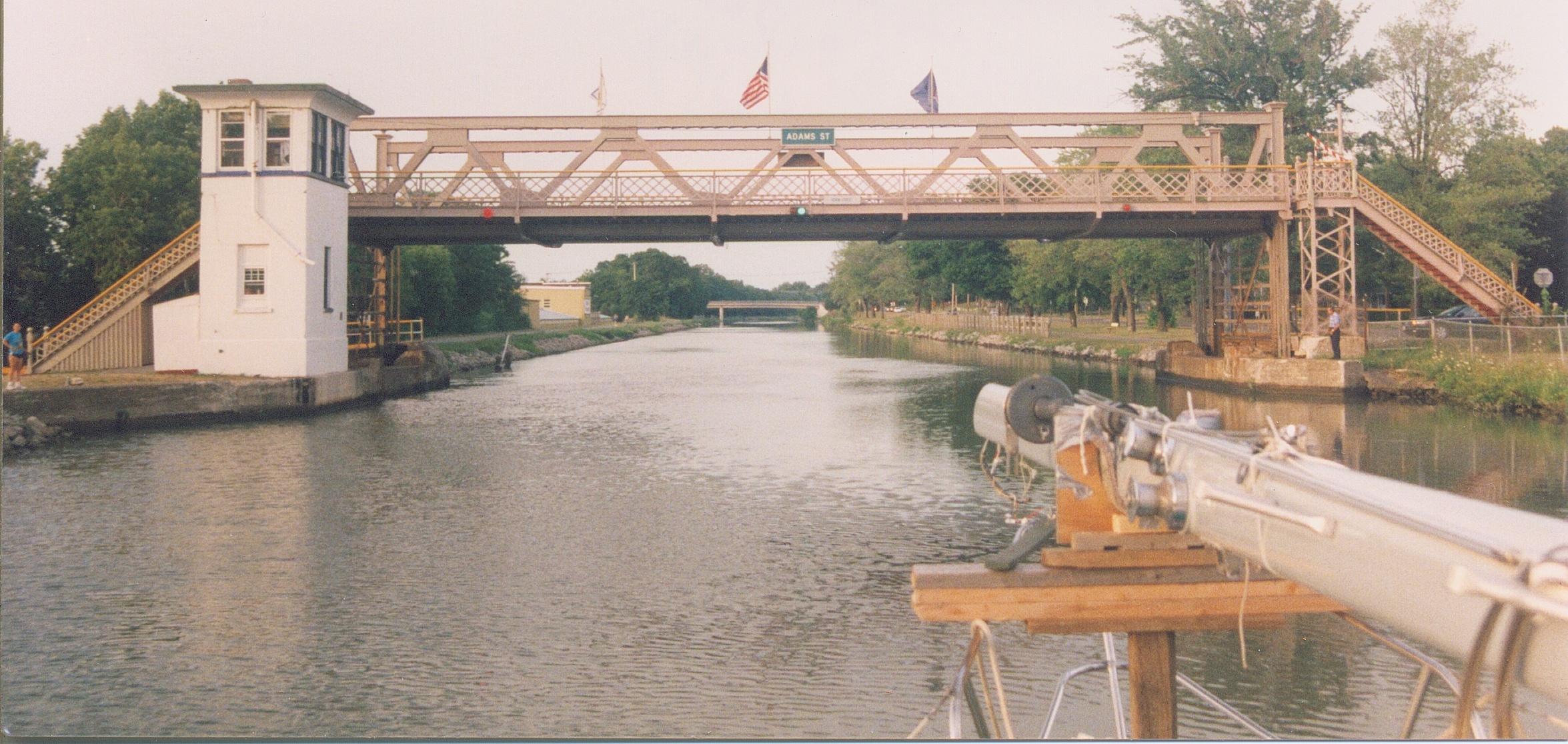
(Originally published in 2012)
The Erie Canal – Part2
Our Erie Canal Passage
We left Tonawanda in the midafternoon after we got the mast tied down, the booms hung up, the awning back in place and everything was shipshape, and we headed up the river for the canal. We were looking forward with no small amount of trepidation to our first ‘locking through’ experience on this canal and it wasn’t long in coming. We encountered our first major set of locks at Lockport, and, thanks to the confidence-building assistance of a very cooperative lockmaster (and our singular previous lock passage back on the Black Rock Canal in Buffalo) , all went surprisingly well. From there we headed on to Middleport a few miles further along, arriving just after dark. Here we learned an important lesson: arriving late is not a good thing. All of the prime spots to tie up along the wall were already gone. As a result, we had to pull off something closely akin to a parallel parking move with our 37-foot boat and 10 feet of mast overhanging at each end – not an easy feat. Let’s just say we managed. Nobody got hurt and nothing got broken (although I’m sure some ears were burning by the time we finished.) In addition another challenge presented itself: finding the local restroom/shower facilities. Most towns along the route have some sort of shower facility to offer canal travelers. Some were simply harder to find than others. Also some stops along the way offered electricity and water hookups.
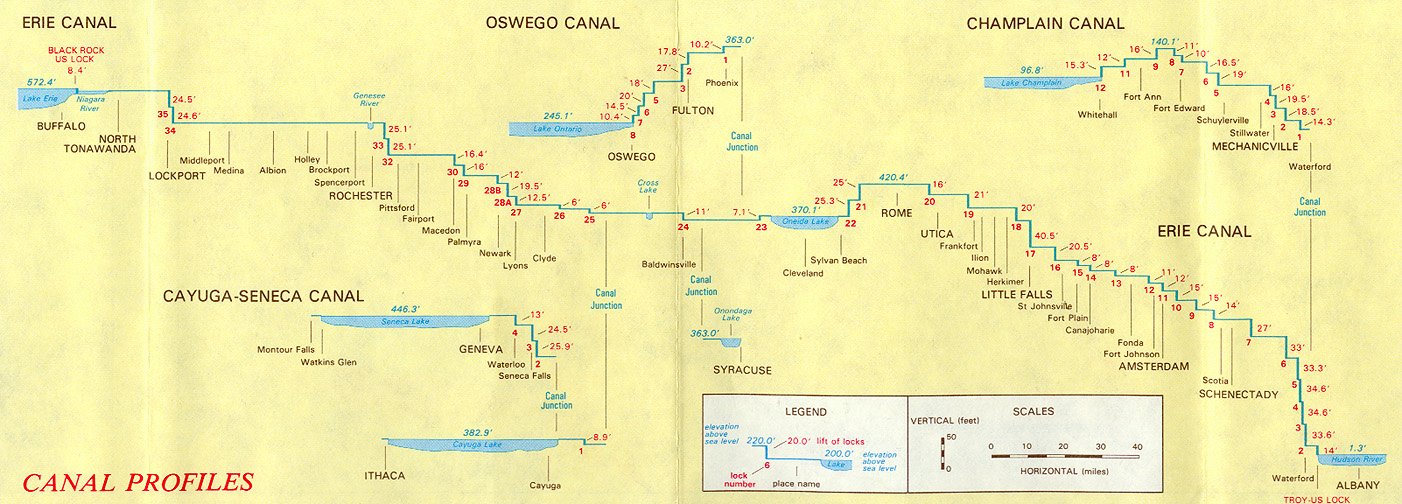
As we motored along lazily, our mast extending from well in front of the bow to past the stern and then some, and us resting comfortably under our improvised awning suspended beneath our horizontal mast, we embraced one of our favorite pastimes – peoplewatching. The brilliant, halcyon summer days brought out outdoor enthusiasts of all genres and the towpaths along the canal were so full of walkers and runners and strollers and bicyclists and other outdoorsy types that at times the trails seemed almost congested. On the narrow canal we felt as if we could simply reach out and touch them at times. Many of them waved or shouted comments and we waved and shouted back or we waved and they waved back in turn, so much so that Annie made the bemused comment that she felt like Forrest Gump in one of the scenes from the movie when he was running across the country. It was that much fun.
Overnight layovers in the towns along the way offered us the chance to check our e-mail messages and take care of our provisioning needs, along with exploring the local specialty shops and tourist dives. In addition it always presented the prospect of satisfying our never-ending urge to find the local ice cream source and a chance to sample the local fare.
When we stopped in Brockport, we tied up just past the first lift bridge. This is an enjoyable little town that has a branch of the State University of New York and has the typical college town atmosphere. It was here that we went in search of and found a couple of pairs of heavy duty rubber gloves for handling the lock grablines which hang down into the locks and are grabbed and held in order to help stabilize the boat as the water level changes. The lines, cables, and grabpipes are always filthy black and are a mess to handle, and gloves are a must. While here, we were invited to take our showers and use the bathrooms over at the local fire hall just a block south of the canal. From Fidelis’ berth we walked over the bridge and up the hill for some groceries. The store actually encouraged us to just use their grocery cart to take our goods back to the boat – small town hospitality at its best and an unexpected convenience.
Fairport, our next stopover, was the only town along the canal where we had to pay a fee for dockage. In their favor, they also had the nicest bathroom facility of anyplace we stopped on the canal and they had a fulltime dockmaster to oversee things. The liftbridge in Fairport has been featured in Ripley’s Believe It or Notas it runs at an angle across the canal while it is also inclined. We also managed to pick up a free copy of an Erie Canal map here that functioned just fine for most purposes during our transit of the canal. Free is always good!
In Newark, NY we spent a bit of a special evening as we tied up at a small canalside park where we were within walking distance of a gas station. We first walked up to the service station and filled our jerry jugs with diesel. Once the filled jugs were stored securely aboard and that chore was done we walked across the bridge over the canal to a little Italian restaurant and had a glass of wine before we then walked across the street to a movie theater to enjoy a movie. All in all, a pleasant night of taking care of business and enjoying some simple pleasures.
After Newark the canal broadens out a little and becomes more of a river before our next stop in the quaint little village of Baldwinsville where we tied up along the wall for the night. We enjoyed eating dinner and having some ice cream at a historic repurposed railway station situated near a big old iron highway bridge and next morning we were off, eastbound toward Brewerton.
Brewerton lies at the western end of Oneida Lake. – We didn’t stay here but there are some commercial marinas available there before you get to the lake. The lockmaster at lock #23 had told us as we passed that he thought it was too windy to cross the lake. We decided to take a look for ourselves and were glad we did. The lake is about 20 miles long and just a few miles wide (never out of sight of shore on either side), but the canal channel passes the entire length of the lake, from west to east, right down the middle. We had heard that Oneida Lake can be treacherous if there is much of a breeze and usually requires an early morning crossing to catch it before the chop kicks up too much. We got lucky and caught a calm day, even though we started late in the morning. Still, by the time we got to the far end of the lake and had to turn beam-on to the small chop in order to get out the far end, we were rocking and rolling pretty good for the last mile or so. When you have a couple hundred pounds of mast four feet above the deck, extending the length of the vessel and then some, it can really accentuate the roll. If I had one piece of advice to offer any potential canal sailboat travelers it would be to make certain your mast is tied down well! – not only for the Oneida Lake crossing but also as a precaution against the rare but not unheard-of ignorant powerboater who doesn’t know the meaning of “no wake.” Crossing the lake took us about 2 hours. Since the lake is not part of the canal, those in a powerboat could just take off at cruising speed running the length in no time flat.
At the eastern end of the lake is Sylvan Beach. We tied up here along the wall for a comfortable stop after a day of doing the lake. There was a canal barge tied up near us and I was able to use some of his equipment to help me start removing my Sta-Lokterminals as a preclude to later replacing our standing rigging. There was also a sizable permanent carnival located here offering rides, carnival food, and entertainment in addition to a swimming beach, and – you guessed it – ice cream. We enjoyed ourselves just wandering around.
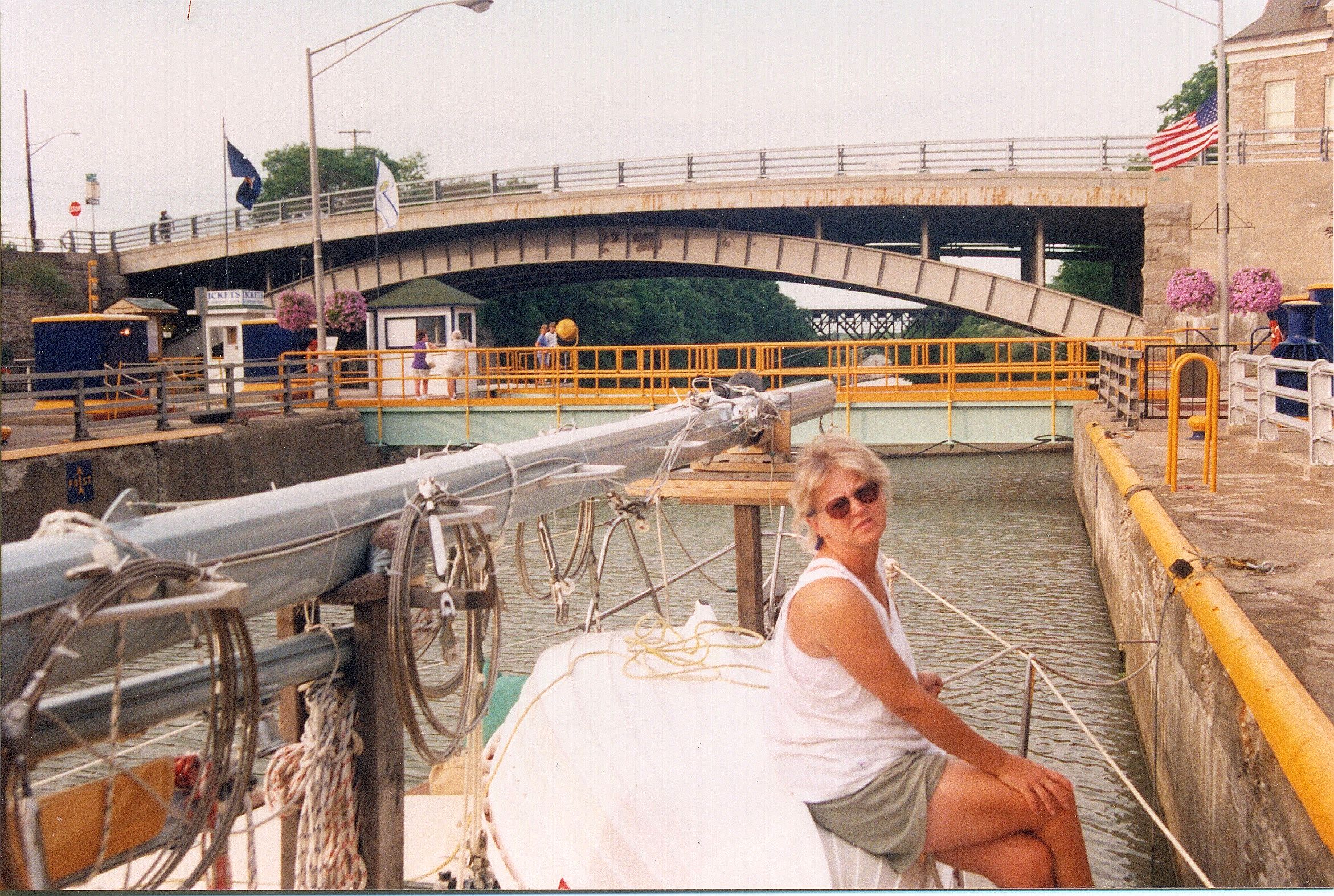
Shortly after Sylvan Beach it was time to work our way up over a little spine of high ground and we encountered the first of our UP locks. Each of these two locks elevated us by 25 feet, so that we climbed 50 feet in one chunk. The lockmaster here was very helpful when we mentioned it was our first time going up. It’s not terribly dramatic but there is a different motion, a little more turbulence, when water is coming into the lock compared to when they are letting the water out. Neither motion is particularly worse than the other, just different. This 50-mile day took us through an additional three more locks and we ended up in Little Falls, another quaint little canal town, where we tied up along the wall. At Little Falls we transitted lock #17, the biggest one of the entire trip, where we dropped 40 feet in one fell swoop. It went fine. It’s just a very weird feeling as you drop deeper and deeper into what feels like a tall narrow room until the walls on every side reach nearly 50 feet above. I suppose if one were claustrophobic it might feel more than just a little strange. We went on to do another 8 locks that day, the most we had done in a single day, and ended the day tied up at the approach to lock #8 along with a couple of foreign flagged boats – one French and one Italian. We had encountered a number of foreigners on our trip who were enjoying the canal passage.
We entered lock number 8 next morning at 0735, ready for our final day on the New York State Barge Canal. We got fuel along the way at the Schenectady Yacht Club and started lock #6 at noon. The last five locks on the canal, #6 through #2, are known as the “flight of five” and drop over 150 feet to sea level and the level of the Hudson River. It took us only until 1:15 in the afternoon to finish lock number 2, about as efficient a passage as one could hope for. This marks the end of the Erie Canal and the start of the Hudson River.
Lock number one is called the “Federal Lock” because it is not operated by the New York Canal authority, but rather by the federal government. It provides a buffer between the carefully regulated canal system and the tidal flow of the Hudson River. The Hudson will give you your first experience with tides, which, even though you are 200 miles from the Atlantic Ocean, will range upwards of five feet. The federal lock left a bad taste with us. The lockmaster here must have been having a bad day, or maybe it was just a bad life. He was deliberately rude and uncooperative. This was the only lock on the trip where we were forced to guide our descent from only one point on the deck of our boat, rather than from the usual bow and stern locations. As a result our overhanging mast bounced against the walls of the lock a couple of times during our descent. As it turned out, no harm, no foul, but the uncooperative lockmaster left us with much greater appreciation for the courtesy and pleasant demeanor of those we had met who ran the state-operated facilities.
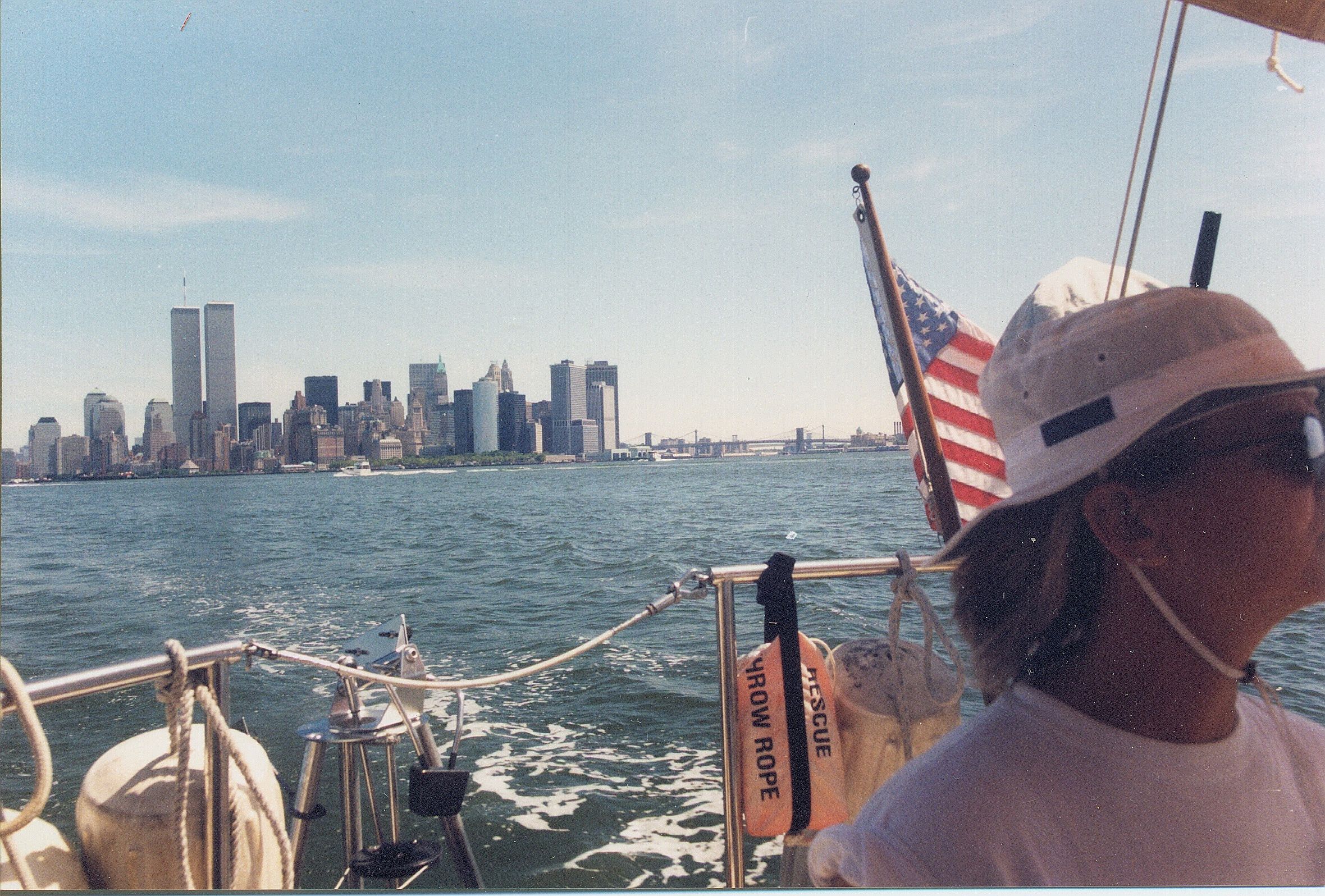
We left the federal lock and continued downriver on our way to Catskill where our new rigging awaited us at Hop-O-Nose Marina. We were eager to get the boat rigged, the mast stepped, and to turn back into a sailboat again.
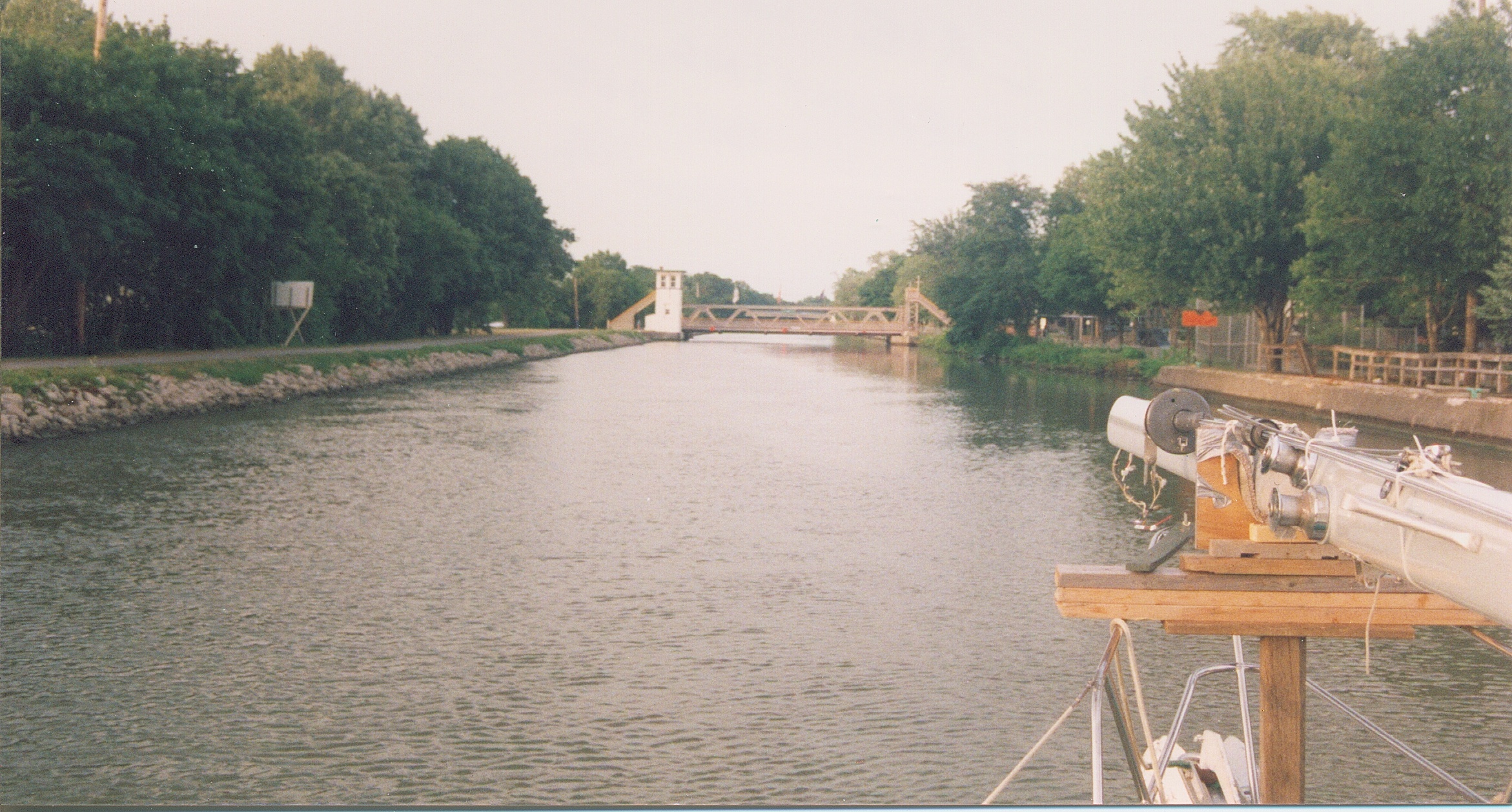
Leave a Reply